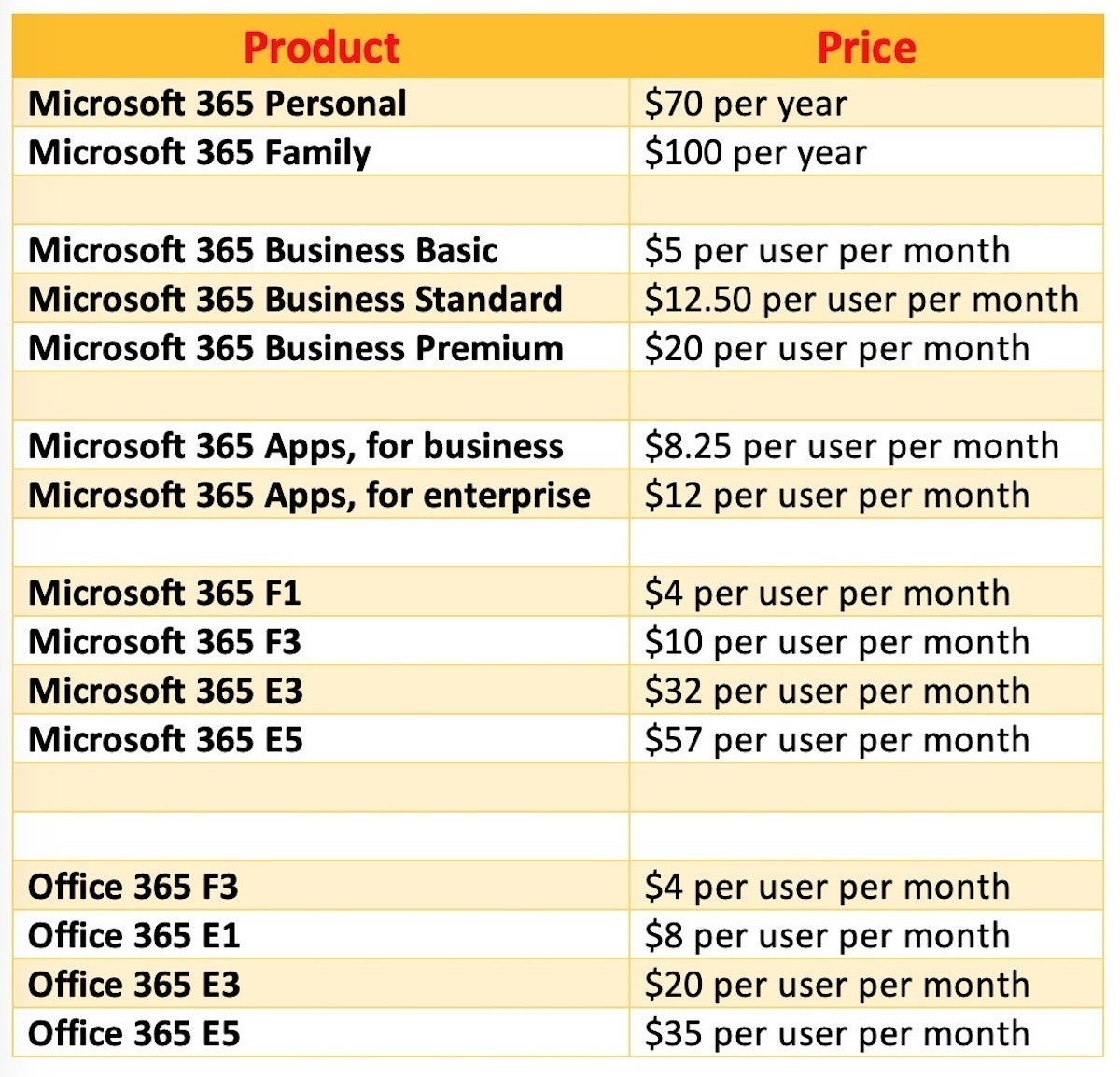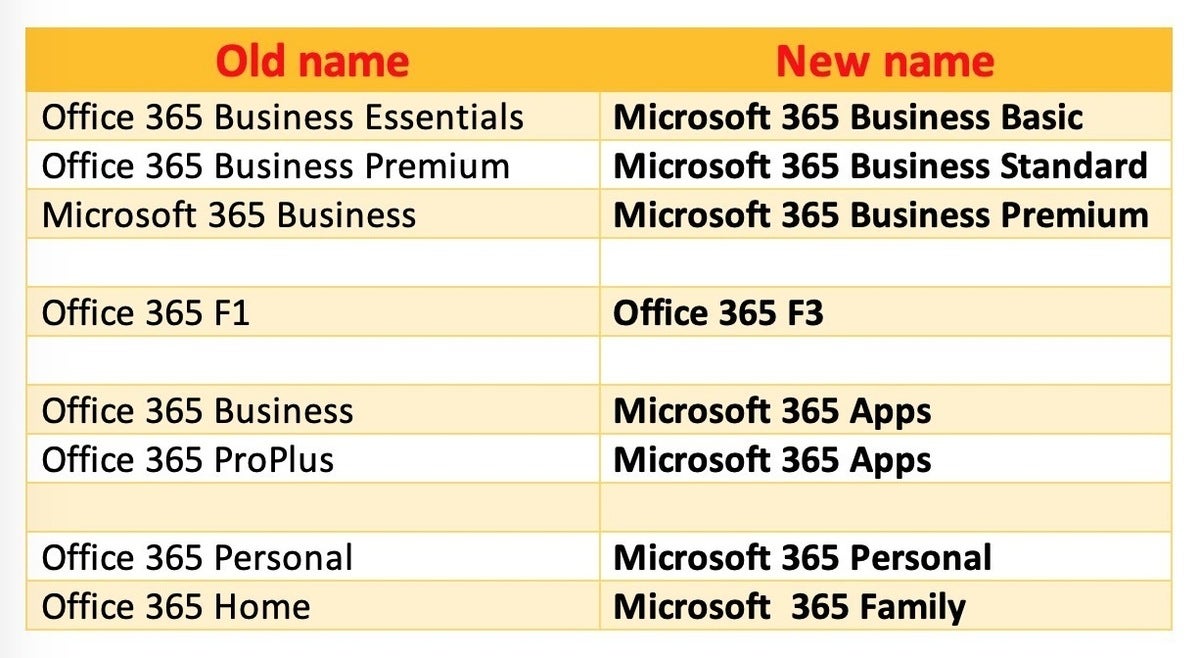advertisement
Microsoft Ousts Office 365, Crowns Microsoft 365 New Monarch
Microsoft’s killing off Office 365. That product nameplate, synonymous with productivity as well as by-subscription software, is on the way out, supplanted by…

Microsoft’s killing off Office 365.
That product nameplate, synonymous with productivity as well as by-subscription software, is on the way out, supplanted by a newer brand, Microsoft 365. The move obscures how users are to gather information about the original and muddies the meaning of the replacement.
Two months ago, Microsoft expanded the definition of Microsoft 365 beyond its 2017 origins. At the end of March, Microsoft announced name changes to the Office 365 subscription plans in the Business line, substituting Microsoft 365 instead. The company did the same for the consumer-grade Office 365 plans.
Microsoft also dumped the Office 365 ProPlus label for Microsoft 365 Apps. All name changes took effect on April 21.
advertisement
This table shows the rebranding results.
In one fell swoop, Microsoft abandoned nearly two-thirds of its Office 365 plans, magically turning them into Microsoft 365. It was the most significant rebranding of its subscription cash cow since the concept’s launch almost nine years ago.
Microsoft 365 becomes the brand
advertisement
Microsoft kicked off Microsoft 365 – M365 for short – in July 2017, with CEO Satya Nadella asserting that it was “a fundamental departure in how we think about product creation.”
Like most bundles, M365 was a collection of independently-available products. As a superset of Office 365, it included all that suite’s software and services. It added other bits, too, including the company’s most advanced security software, as well as management tools. But it was the inclusion of Windows 10 that set M365 apart; M365 was the first subscription to marry Microsoft’s two biggest client-side revenue generators, Windows and Office.
Existing Office 365 subscriptions remained, creating parallel product lines that shared naming conventions, including 365 and plan designations like E5 for an enterprise subscription and business for a deal designed for small- and medium-sized companies. While there was some early – and understandable – confusion about the necessity for two lines, Microsoft made it clear that it saw revenue opportunities in upselling customers on M365, implying that the newer product family was favoured.
advertisement
Until April and the brand expansion, the key differentiator between Microsoft and Office 365 plans was the presence of Windows in the former. All Microsoft 365 subscriptions included user-based licenses to the OS; none of O365 (for Office 365) did so. It wasn’t much of a hook to hang a product line on – not when employees of subscribing firms likely knew both as simply “Office” – but it was something.
“It wasn’t much of a hook to hang a product line on – not when employees of subscribing firms likely knew both as simply “Office” – but it was something.”
By putting numerous plans that lacked Windows under the M365 brand, Microsoft eliminated the definitional differences between Office and Microsoft 365. In short, Microsoft 365 became a broader brand name that could be assigned to virtually any by-subscription product. And it was, considering the vast gulf between Microsoft 365 Home and, say, Microsoft 365 E3. The only things those two have in common are a name and Office 365’s components.
Of the 10 Office 365 consumer, SMB and enterprise plans existing at the start of 2020, more than half (6) were flipped to Microsoft 365 in April. With one announcement; Office 365 went from the dominant brand – by a 10 to 5, or 2:1, margin – to the runt of the two (losing to Microsoft 365 in a 4 to 11 beatdown).
It’s obvious from the recent rebranding that Microsoft values M365 over Office 365 and considers it the brand of the future (as it likely did from M365’s inception). Office 365, meanwhile, has been demoted. It’s now possible to imagine that Microsoft may eliminate O365 altogether, either turning the remaining Office-only subscriptions into M365-named SKUs (stock-keeping units) or simply scratching them off the product list.
Whether Microsoft keeps or tosses the remaining Office 365 SKUs is largely irrelevant at this point, as M365 already has an overwhelming advantage. Based on a number, M365 now accounts for almost three-quarters of all subscriptions designed for consumers, SMBs and enterprises.
In effect, Microsoft has discarded a brand with enormous name recognition, one it had carefully built up over almost a decade but which had a tie to a much, much older brand, Office, that in itself was eponymous with the product category. Microsoft spent considerable resources improving and promoting the Office 365 bundle as product, and has had – as the company’s executives have told us at nearly every earnings call opportunity – great success in selling.
Microsoft largely surrendered the brand, which wasn’t, as far as Computerworld knows, under assault from anti-office activists or had suffered a reputational crisis that led tabloids to run gaudy tales and cause self-appointed moralists to gesture from podiums wildly. Microsoft surrendered Office 365 without a fight.
What the hell?
Did the brand just get too small?
As to the Why? of Microsoft’s action, the company has taken stabs at explaining itself.
One simply asserted that subscriptions had outgrown the Office name, that that label was too small for what Microsoft planned, if not yet what it had delivered.
“These ((name)) changes represent our ambition to continue to drive innovation in Microsoft 365 that goes well beyond what customers traditionally think of as Office,” Jared Spataro, Microsoft 365’s top executive, wrote in a March 30 post to a company blog. “The Office you know and love will still be there, but we’re excited about the new apps and services we’ve added to our subscriptions over the last few years and about the new innovations we’ll be adding in the coming months.”
Elsewhere, Microsoft’s reasoning has been hazier still.
“Computing experiences … are expanding to many devices as people move from home to work to on the go,” the company argued in the 10-K filed with the U.S. Securities and Exchange Commission (SEC) in August 2019. “These modern needs, habits, and expectations of our customers are motivating us to bring Microsoft Office 365, Windows platform, devices, including Microsoft Surface, and third-party applications into a more cohesive Microsoft 365 experience.”
“In effect, Microsoft has discarded a brand with enormous name recognition, one it had carefully built up over almost a decade but which had a tie to a much, much older brand, Office, that in itself was eponymous with the product category.”
Nowhere, though, did Microsoft detail how it would transition from a smaller definition of brand to one larger, or when it would do so, instead simply dropping the changes on customers this year. Nowhere has Microsoft reasoned why, after obviously choosing Microsoft 365 as the brand, there remained parallel product lines.
As the table below shows, there are now only four O365 SKUs, all enterprise-grade plans: F3, E1, E3 and E5 (Microsoft likes odd numbers, eschews even numbers, in its O365 and M365 labels). Those plans come with list prices between $4 and $35 per user per month, and vary by the included bits, with the most expensive offering the most features, tools and services. (Office 365 F3, which before April 1 was known as Office 365 F1, is aimed at “front-line” workers, those who spend most of their work time in the field, on a factory floor or in service-related chores.)

Microsoft 365 plans aimed at businesses include F1 and F3, E3 and E5, and Business Basic, Business Standard and Business Premium. (The last three come with a Microsoft-mandated maximum of 300 users.) These plans cost $4 and $10 per user per month; $32 and $57 per user per month; and $5, $12.50 and $20 per user per month, respectively. The Microsoft 365 Apps (for enterprise) plan, formerly named Office 365 ProPlus, runs $12 per user per month; the similarly-named Microsoft 365 (for business), once named “Office 365 Business,” with essentially the same set of applications, costs only $8.25 per user per month.
Finding the elusive Office 365
Nothing speaks better to the demotion of Office 365 as a brand than the difficulty users encounter just finding its plans.
Meanwhile, getting to Microsoft 365 is laughably easy, as if every road, like those to Rome, now lead to the newer, more expansive label.
- Click on the Office tab on Microsoft.com, and you’re taken to this page, which although it claims “…you’re in the right place,” lists only Microsoft 365 plans on the pages provided by links for home users, SMBs and enterprises.
- Click on the Microsoft 365 tab on Microsoft.com, and you’re taken to – no, not to Office 365 as you might expect in such an Upside Down – but to a page “Introducing Microsoft 365” that does just that in spades.
- Don’t bother clicking the Products tab on this page, then the Office 365 item way on the right (under More). By now you should have figured out that that would take you to – yes, you’re right – the same “If you’re looking for Office 365, you’re in the right place” page as in the first bullet point.
- To find the remaining Office 365 plans – something Microsoft doesn’t think you’ll want to do, as hard as it makes it – starting from Microsoft.com, click on Office, which takes you here. Scroll until you see Frequently asked questions, then click on What Office plans are still available? Finally, click on the link Office 365 plans for enterprise.
Sheeze.
